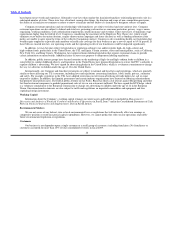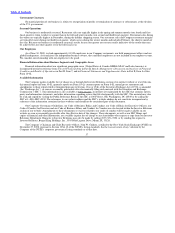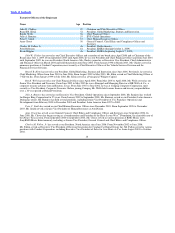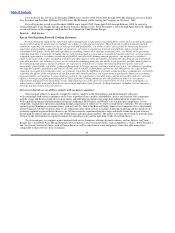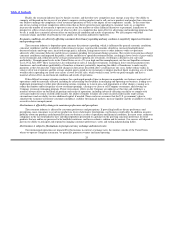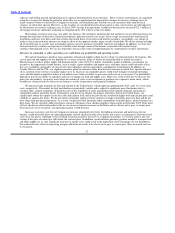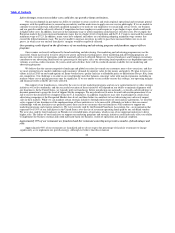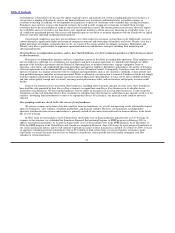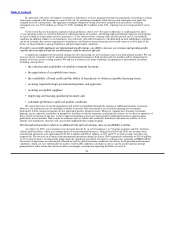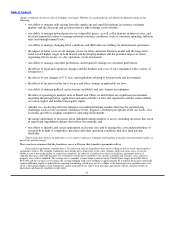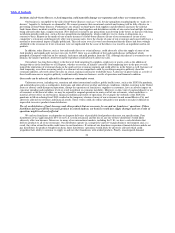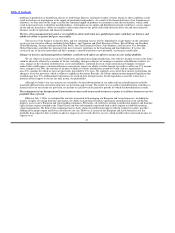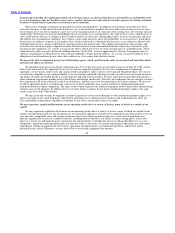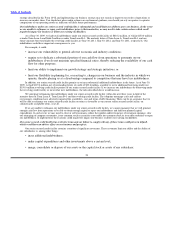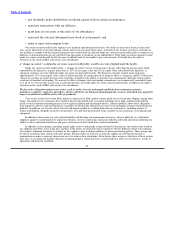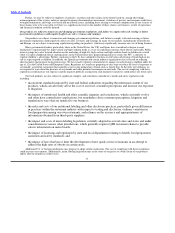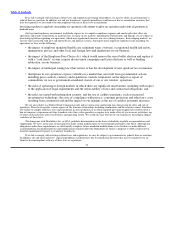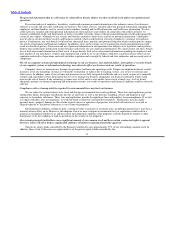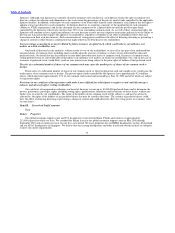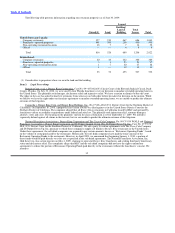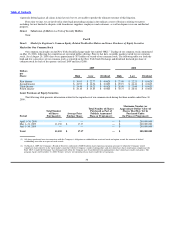Burger King 2009 Annual Report Download - page 28
Download and view the complete annual report
Please find page 28 of the 2009 Burger King annual report below. You can navigate through the pages in the report by either clicking on the pages listed below, or by using the keyword search tool below to find specific information within the annual report.
Table of Contents
Incidents of food−borne illnesses or food tampering could materially damage our reputation and reduce our restaurant sales.
Our business is susceptible to the risk of food−borne illnesses (such as e−coli, bovine spongiform encephalopathy or “mad cow’s
disease,” hepatitis A, trichinosis or salmonella). We cannot guarantee that our internal controls and training will be fully effective in
preventing all food−borne illnesses. Furthermore, our reliance on third−party food suppliers and distributors increases the risk that
food−borne illness incidents could be caused by third−party food suppliers and distributors outside of our control and multiple locations
being affected rather than a single restaurant. New illnesses resistant to any precautions may develop in the future, or diseases with long
incubation periods could arise, such as bovine spongiform encephalopathy, which could give rise to claims or allegations on a
retroactive basis. Reports in the media of one or more instances of food−borne illnesses in one of our restaurants or in one of our
competitor’s restaurants could negatively affect our restaurant sales, force the closure of some of our restaurants and conceivably have a
national or international impact if highly publicized. This risk exists even if it were later determined that the illness had been wrongly
attributed to the restaurant or if our restaurants were not implicated but the cause of the illness was traced to an ingredient used in our
products.
In addition, other illnesses, such as foot and mouth disease or avian influenza, could adversely affect the supply of some of our
food products and significantly increase our costs. In 2007, there was an outbreak of foot and mouth disease in England, which
prompted a European−wide ban on live animals, fresh meat and milk products from the U.K. Although this disease is extremely rare in
humans, the negative publicity about beef and beef products could adversely affect our sales.
Our industry has long been subject to the threat of food tampering by suppliers, employees or guests, such as the addition of
foreign objects in the food that we sell. Reports, whether or not true, of injuries caused by food tampering have in the past severely
injured the reputations of restaurant chains in the quick service restaurant segment and could affect us in the future as well. Instances of
food tampering, even those occurring solely at restaurants of our competitors could, by resulting in negative publicity about the
restaurant industry, adversely affect our sales on a local, regional, national or worldwide basis. A decrease in guest traffic as a result of
these health concerns or negative publicity could materially harm our business, results of operations and financial condition.
Our results can be adversely affected by disruptions or catastrophic events.
Unforeseen events, including war, terrorism and other international conflicts, public health issues, such as the H1N1 flu pandemic,
and natural disasters such as earthquakes, hurricanes and other adverse weather and climate conditions, whether occurring in the United
States or abroad, could disrupt our operations, disrupt the operations of franchisees, suppliers or customers, have an adverse impact on
consumer spending and confidence levels or result in political or economic instability. Moreover, in the event of a natural disaster or act
of terrorism, or the threat of either, we may be required to suspend operations in some or all of our restaurants, which could have a
material adverse effect on our business, financial condition and results of operations. For example, the outbreak of the H1N1 flu
pandemic in Mexico during fiscal 2009 resulted in the temporary closure of many of our restaurants in and around Mexico City and
adversely affected our revenues and financial results. These events could also reduce demand for our products or make it difficult or
impossible to receive products from distributors.
We rely on distributors of food, beverages and other products that are necessary for our and our franchisees’ operations. If these
distributors fail to provide the necessary products in a timely fashion, our business would face supply shortages and our results of
operations might be adversely affected.
We and our franchisees are dependent on frequent deliveries of perishable food products that meet our specifications. Four
distributors service approximately 85% of our U.S. system restaurants and the loss of any one of these distributors would likely
adversely affect our business. Moreover, in many of our international markets, including the U.K., we have a sole distributor that
delivers products to all of our restaurants. Our distributors operate in a competitive and low−margin business environment and, as a
result, they often extend favorable credit terms to our franchisees. If certain of our franchisees experience financial distress and do not
pay distributors for products bought from them, those distributors’ operations would likely be adversely affected which could
jeopardize their ability to continue to supply us and our other franchisees with needed products. Finally, unanticipated demand,
26


